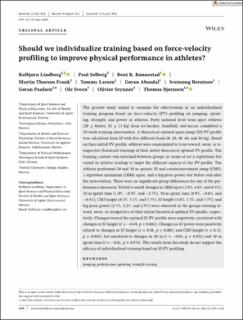Should we individualize training based on force-velocity profiling to improve physical performance in athletes?
Lindberg, Kolbjørn Andreas; Solberg, Paul André; Larsen, Tommy Mella; Abusdal, Gøran; Berntsen, Sveinung; Paulsen, Gøran; Sveen, Ole; Seynnes, Olivier R.; Bjørnsen, Thomas; Rønnestad, Bent R.; Frank, Martin Thorsen
Peer reviewed, Journal article
Published version
Permanent lenke
https://hdl.handle.net/11250/2833742Utgivelsesdato
2021Metadata
Vis full innførselSamlinger
- Artikler / Articles [2119]
- Publikasjoner fra Cristin [1107]
Originalversjon
Scandinavian Journal of Medicine & Science in Sports. 2021, 31(12), 2198-2210. 10.1111/sms.14044Sammendrag
The present study aimed to examine the effectiveness of an individualized training program based on force-velocity (FV) profiling on jumping, sprinting, strength, and power in athletes. Forty national level team sport athletes (20 ± 4years, 83 ± 13 kg) from ice-hockey, handball, and soccer completed a 10-week training intervention. A theoretical optimal squat jump (SJ)-FV-profile was calculated from SJ with five different loads (0, 20, 40, 60, and 80 kg). Based on their initial FV-profile, athletes were randomized to train toward, away, or irrespective (balanced training) of their initial theoretical optimal FV-profile. The training content was matched between groups in terms of set x repetitions but varied in relative loading to target the different aspects of the FV-profile. The athletes performed 10 and 30 m sprints, SJ and countermovement jump (CMJ), 1 repetition maximum (1RM) squat, and a leg-press power test before and after the intervention. There were no significant group differences for any of the performance measures. Trivial to small changes in 1RM squat (2.9%, 4.6%, and 6.5%), 10 m sprint time (1.0%, −0.9%, and −1.7%), 30 m sprint time (0.9%, −0.6%, and −0.4%), CMJ height (4.3%, 3.1%, and 5.7%), SJ height (4.8%, 3.7%, and 5.7%), and leg-press power (6.7%, 4.2%, and 2.9%) were observed in the groups training toward, away, or irrespective of their initial theoretical optimal FV-profile, respectively. Changes toward the optimal SJ-FV-profile were negatively correlated with changes in SJ height (r = −0.49, p < 0.001). Changes in SJ-power were positively related to changes in SJ-height (r = 0.88, p < 0.001) and CMJ-height (r = 0.32, p = 0.044), but unrelated to changes in 10 m (r = −0.02, p = 0.921) and 30 m sprint time (r = −0.01, p = 0.974). The results from this study do not support the efficacy of individualized training based on SJ-FV profiling.
Beskrivelse
This is an open access article under the terms of the Creat ive Commo ns Attri bution License, which permits use, distribution and reproduction in any medium, provided the original work is properly cited.
